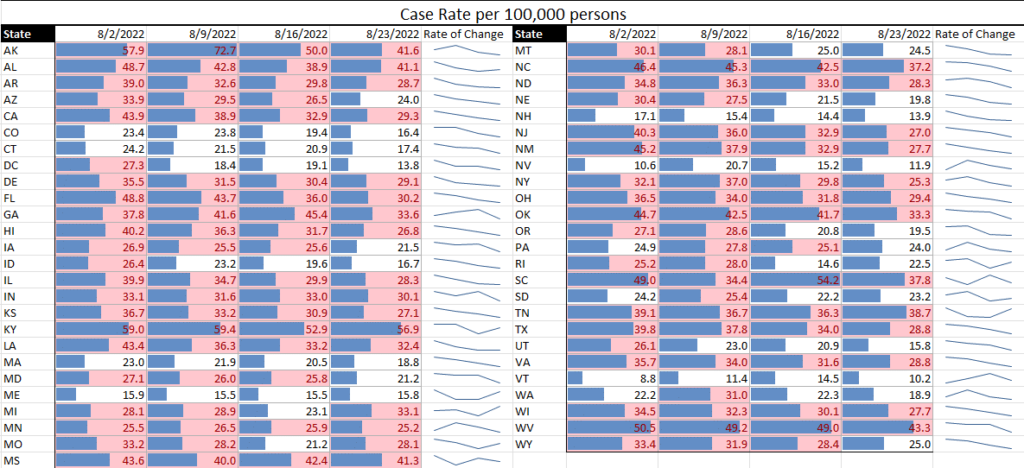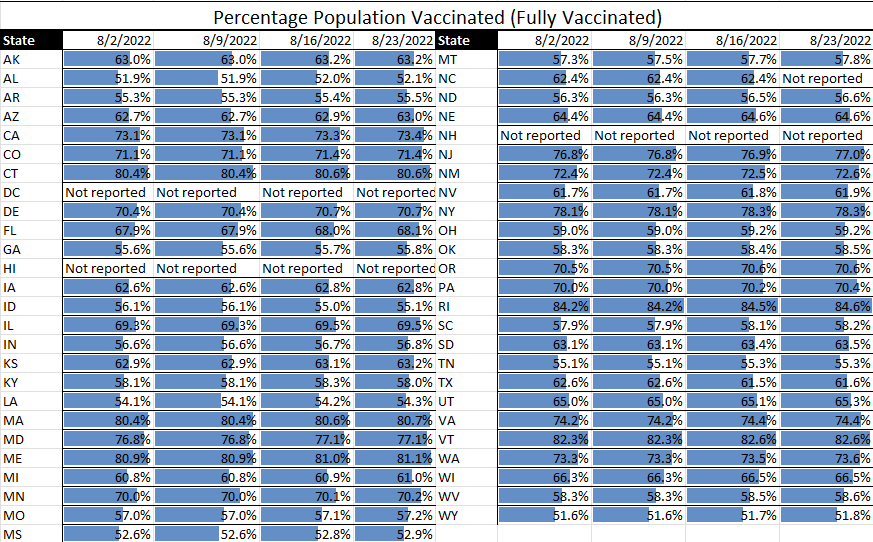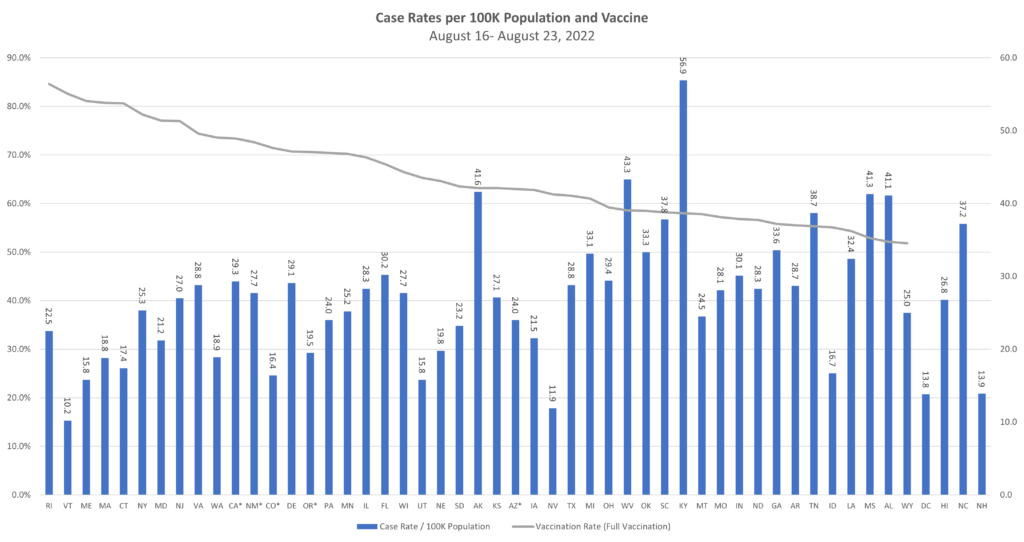Key Points:
COVID
- In today’s Recommendation for Industry, we discuss the continued trend of Monkeypox and Covid. Read more below.
- Regular physical activity tied to lower risk of COVID, poor outcomes. At least 150 minutes (2.5 hours) of moderate physical activity—or 75 minutes (1.2 hours) of vigorous exercise—weekly was linked to a lower risk of COVID-19 infection, hospitalization, severe illness, and death during periods dominated by the Beta and Delta variants, according to a systematic review and meta-analysis published. Adults who engaged in moderate physical activity for at least 150 minutes or vigorous exercise for at least 75 minutes per week were at lower risk for COVID-19 infection (-11%), hospitalization (-36%), severe COVID-19 (-44%), and COVID-related death (-43%). The relative risks (RRs) for regular exercisers were 0.89 for infection, 0.64 for hospital admission, 0.66 for severe illness, and 0.57 for COVID-related death.
- BA.5, BA.4.6 COVID variants continue US expansion. BA.5 now accounts for 88.9% of sequenced samples, up slightly from 88% the previous week. Also, BA.4.6, which first gained traction in the central Midwest, gained more ground and now accounts for 6.3% of sequenced samples, up from 5.3% the week before. The nation’s 7-day average for new daily cases continues to fall slowly and is at 92,602, the lowest since mid-May, according to the New York Times tracker. The 7-day average for new daily deaths is 459. In related news, Pfizer and BioNTech updated its efficacy findings as part of an ongoing phase 2/3 trial of its three-dose primary series for kids aged 6 months through 4 years. Overall, the study suggests 73.2% efficacy, reinforcing initial findings.
- Moderna files for emergency use of BA.4/BA.5 Omicron booster. Following a similar move made by Pfizer and BioNTech, Moderna has submitted their application for emergency use of their bivalent COVID booster vaccine that targets BA.4 and BA.5 Omicron subvariants. The goal of Moderna is to be able to administer doses in September. In a statement, Moderna said its application is for a 50-microgram booster dose for adults ages 18 and older. It targets the original SARS-CoV-2 strain, plus the Omicron BA.4 and BA.5 subvariants. The Biden administration has signaled that it will offer updated boosters to people ages 12 and older soon after Labor Day, according to the New York Times. In its weekly report on the pandemic, the WHO said cases declined 9% last week, with deaths down by 15% compared to the previous week.
Monkeypox
- Trials for monkeypox antiviral, fractional vaccine dosing launch. US officials have announced the launch of clinical trials to gauge how effective the antiviral drug tecovirimat (Tpoxx) and how protective the intradermal fractional dose of Jynneos vaccine used to treat monkeypox. The UK study plans for Tpoxx are to enroll 500 or more patients who will either be given a 14-day course of the antiviral (2 daily doses of 600 milligrams) or a placebo. The participants will take the medication at home, and the primary outcome will be the rate at which skin and mucosal lesions heal, and the rate at which throat and lesion swabs test negative for the virus. Twenty-five monkeypox-confirmed patients took oral tecovirimat which was well tolerated by all patients with monkeypox infection, with minimal side effects. Ten patients had complete resolution of lesions by day 7 of therapy, while 23 (92%) had resolution of lesions and pain by day 21. The United States case count is at 15,433 cases, the most of any country in the world.
Food Safety & Public Health
- Tomato flu outbreak in India spreads to two more states. An outbreak of a new viral infection referred to as tomato flu that was first detected in children in the southern Indian state of Kerala in May has spread to two other states. According to an article in the Lancet Respiratory Medicine, 82 children aged under five had been diagnosed with the virus in Kerala as of 26 July. Scientists are still trying to identify exactly what this virus is. It has been referred to as tomato flu because of the painful red blisters it produces on the body, and it is very contagious. Children are particularly vulnerable because it spreads easily through close contact, such as via nappies, touching unclean surfaces or putting things in mouths.
- Study finds most EU Salmonella outbreaks involve eggs. Eggs have been identified as the main food source of Salmonella outbreaks throughout Europe, according to a study, pork and general meat products followed. Data from 2015 to 2019 was collected for this study. In total, 1,508 Salmonella outbreaks were included in the analysis. Of these, 1,040 were caused by simple foods and 468 by unknown food sources.
- Tahini sold at Walmarts nationwide recalled over Salmonella. Rushdi Food Industries, an Israeli-based manufacturer, is recalling certain Mighty Sesame 10.9 Oz Organic Tahini (Squeezable) because of potential Salmonella contamination. The recalled product was distributed to stores located in New York, New Jersey, and Connecticut as well as nationwide stores during the first two weeks of May. Mighty Sesame 10.9 oz Organic Tahini (Squeezable) with a UPC code of 858313006208 and an expiration date of March 28, 2023, is the product being recalled.
- Romaine on Wendy’s sandwiches linked to multistate E. coli outbreak. Thirty-seven individuals have been deemed ill from romaine lettuce associated with Wendy’s. These people are in four different states: Michigan, Ohio, Pennsylvania, and Indiana. Investigation of this outbreak is still ongoing.
- Since this is an evolving outbreak, case numbers are being collected and tallied by several sources and may not completely agree. Throughout the investigation of romaine lettuce associated with Wendy’s sandwiches, there is an increasing gap of patients being reported by state and federal services. The CDC has recorded a total of 37 individuals infected while the Michigan Department of Health and Human Services has confirmed 53 patients. Ohio has confirmed 22 cases when the CDC has only 19 reported from the state. Several patients in both Ohio and Michigan have been diagnosed with the hemolytic uremic syndrome (HUS), which is a type of kidney disease that often requires dialysis and sometimes results in kidney transplants and death.
Recommendations for Industry
Continuing Trending of Monkeypox and Covid
Starting last week as part of TAG’s Communicable Disease Risk Management services, our weekly matrix now includes data and assessment of monkeypox as well as that of Covid. Below is discussion and graphics related to the most recent status of each.
- Monkeypox. While the graphic, sourced from CDC, appears to show a reduction in cases, it is important to understand that there is a reporting lag of two to three weeks. As the note on the graphic states, case counts in the shaded region (previous 3 weeks) are likely to increase due to the virus’ incubation period (7-21 days) and the time to report to CDC. So while the data appears encouraging, it is too early to say whether we are truly seeing a flattening. The good news is that we are not seeing a massive increase either, based on CDC data.
- Covid. The downward trend we’ve been seeing in recent weeks is continuing with almost every state in the U.S. showing a decrease in case rates. Even with the decrease, however, the TPR and case rates in some states are still reasonably high, so we continue to recommend that precautions be taken.
TAG is continuing to expand its Communicable Disease communication and services beyond Covid. Contact us if you need assistance or would like information on accessing our full Communicable Disease Risk Matrix or Monkeypox Planning & Response Toolkit.
Risk Matrix






In case you missed it:
COVID
- In Tuesday’s Recommendation for Industry, we discussed flu season in the Southern Hemisphere. Read more here.
- Serious adverse events rare after COVID-19 boosters in young kids. Data collected from two vaccine safety surveillance programs in the first 10 weeks of administration of third doses of the Pfizer/BioNTech COVID-19 to US children aged 5 to 11 years show that serious adverse events were rare. The most common adverse reactions included injection-site pain (66.7%), fatigue (28.9%), and headache (19.9%). Most reactions were reported the day after vaccine receipt and were mild. Estimated vaccine effectiveness (VE) 0 to 13 days after two doses was 75.5% among 18-year-olds, 80.4% among those aged 16 or 17, and 79.2% among those 12 to 15. Thirty to 59 days after a second dose, VE waned to 71.3% among 18-year-olds, 61.5% among those 16 or 17, and 49.6% among those 12 to 15. Thirty to 59 days after a third dose, VE fell to 55.2% among 18-year-olds.
- COVID-19 survivors still at higher risk of neurologic disorders 2 years later. Rates of “brain fog,” dementia, psychotic disorders, and epilepsy or seizures remained elevated 2 years after COVID-19 infection, according to a study of nearly 1.3 million adults and children in the United States, Australia, Europe, and Asia. The risk of common psychiatric disorders returned to baseline within 1 or 2 months (43 days for mood disorders, 58 days for anxiety disorders) and then equalized with that of controls by 1.1 years (anxiety) and 1.3 years (mood disorders).
- Pfizer files for emergency use of its BA.4/BA.5 Omicron booster. Pfizer filed an emergency use of their new bivalent booster in hopes they will ship the vaccine in September. The FDA told Pfizer it could submit clinical data for its bivalent BA.1 vaccine alongside preclinical and manufacturing data on its BA.4/BA.5 vaccine. Preclinical data in animals suggest that the BA.4/BA.5 bivalent booster prompts a strong neutralization antibody response against Omicron BA.1, BA.2, and BA.4/BA.5 variants, as well as to the original SARS-CoV-2 virus. New CDC data on COVID-19 cases and deaths show that people ages 50 and up who have had one booster dose have an 83% reduction in deaths, and those with both recommended booster shots have a 94% reduction in death.
Monkeypox
- Survey shows high intent to get the monkeypox vaccine but problems self-diagnosing. A study today in Eurosurveillance shows 70% of surveyed men who have sex with men (MSM) in the Netherlands said they intended to vaccinate against monkeypox, and 44% showed high intention for self-isolation after diagnosis. Within the survey, only 52.3% of participants could correctly identify pictures of monkeypox lesions on the face. In US news, federal officials will make 1.8 million more Jynneos vaccine doses available next week.
- Evidence of monkeypox virus found on household surfaces. A study in Morbidity and Mortality Weekly Report shows multiple surface sites testing positive for monkeypox virus genetic material in a household of two people infected with monkeypox in Utah. UDHHS sampled 30 objects in the home of the infected individual after 20 days of being isolated. Of the 30 specimens, 21 (70%) yielded positive real-time polymerase chain reaction (PCR) results. Three of the positive swabs came from porous items such as cloth furniture and blankets. Seventeen of the eighteen positives out of twenty-one came from nonporous surfaces (handles and switches) while one came from a mixed-surface type (chairs). The researchers concluded their results with the following recommendation: “Persons living in or visiting the home of someone with monkeypox should follow appropriate precautions against indirect exposure and transmission by wearing a well-fitting mask, avoiding touching possibly contaminated surfaces, maintaining appropriate hand hygiene, avoiding sharing eating utensils, clothing, bedding, or towels, and following home disinfection recommendations.”
- CDC cut down the paperwork from 3 to 4 hours to obtain Tpoxx (tecovirimat) to only four forms.
- US total case count is at 14,115 cases.
Food Safety & Public Health
- Countries face shortages of drugs, some for life-threatening conditions. Countries around the world, including the United States, are experiencing a medicine shortage to treat some conditions such as HIV and diabetes, which clinicians say could threaten patient health.
- New Ebola case in DRC likely linked to earlier outbreak. There was a confirmed finding of an individual who passed away on August 15th in the Democratic Republic of the Congo that had Ebola. The individual was a 46-year-old woman who was initially hospitalized for different problems. Persistent virus in survivors is known to trigger flare-ups, and following the large outbreak, there were two other small events in the same area, both thought to be linked to earlier human cases in the area. One that began in February 2021 resulted in 12 cases, 6 of them fatal. And one that started that October led to 11 cases, 6 of them fatal.
- Here’s the checklist for the new FDA food traceability rule that’s coming up. This strict rule will become official on November 7th, 2022. Some of the “high-risk” products that will be under this rule are cheeses other than hard cheese, crustaceans, cucumbers, finfish, fresh herbs, fresh cut fruits and vegetables, leafy greens, melons, mollusks, nut butters, peppers, ready-to-eat deli salads, shell eggs from domesticated hens, sprouts, tomatoes, and tropical tree fruits. The details for what is required from this rule can be found here.





